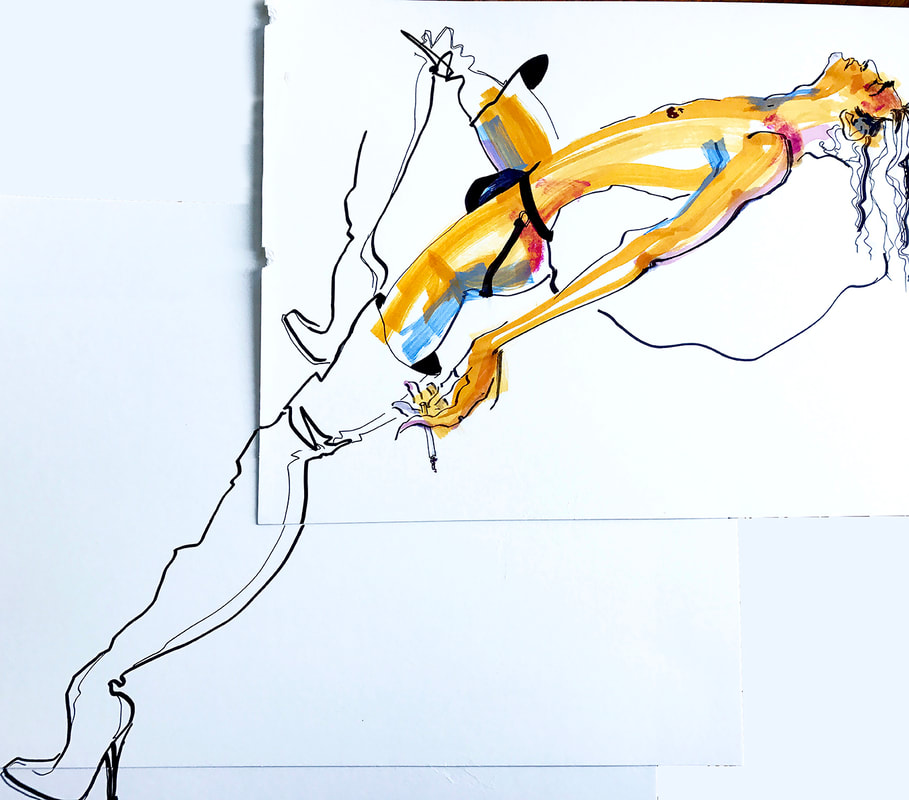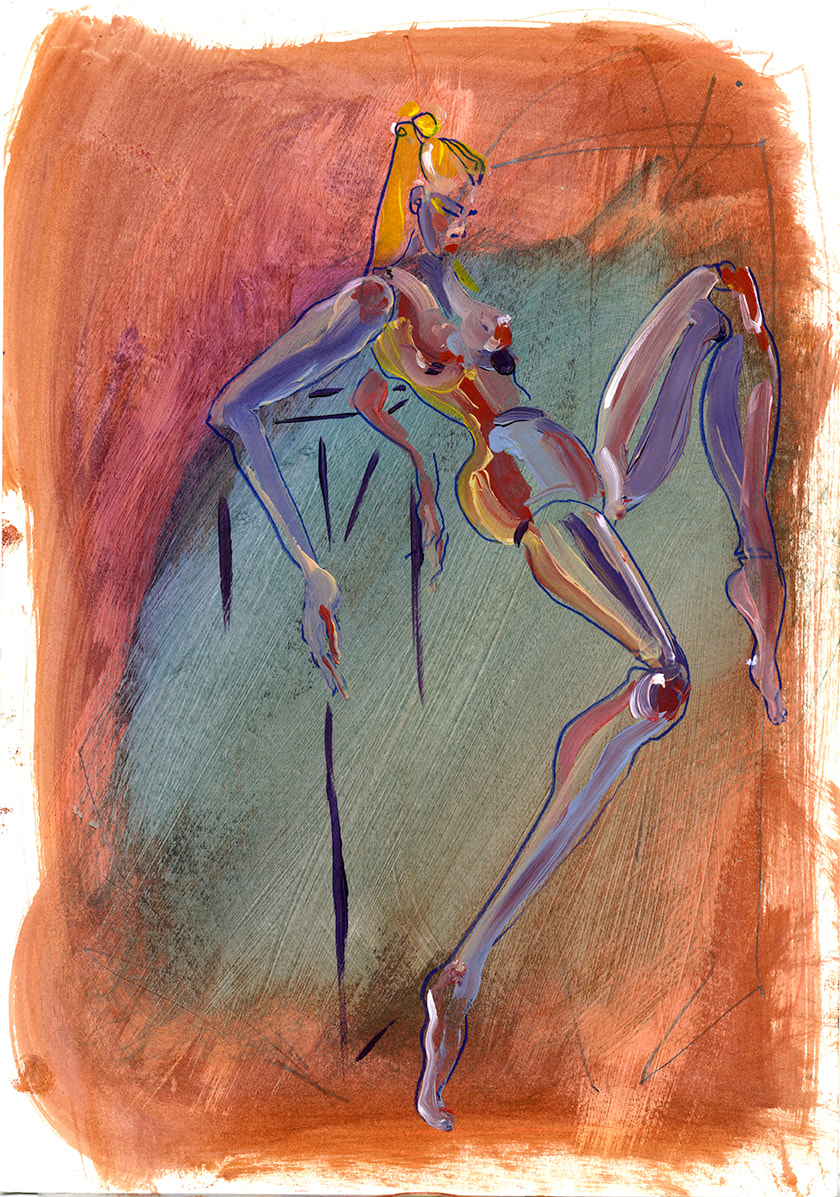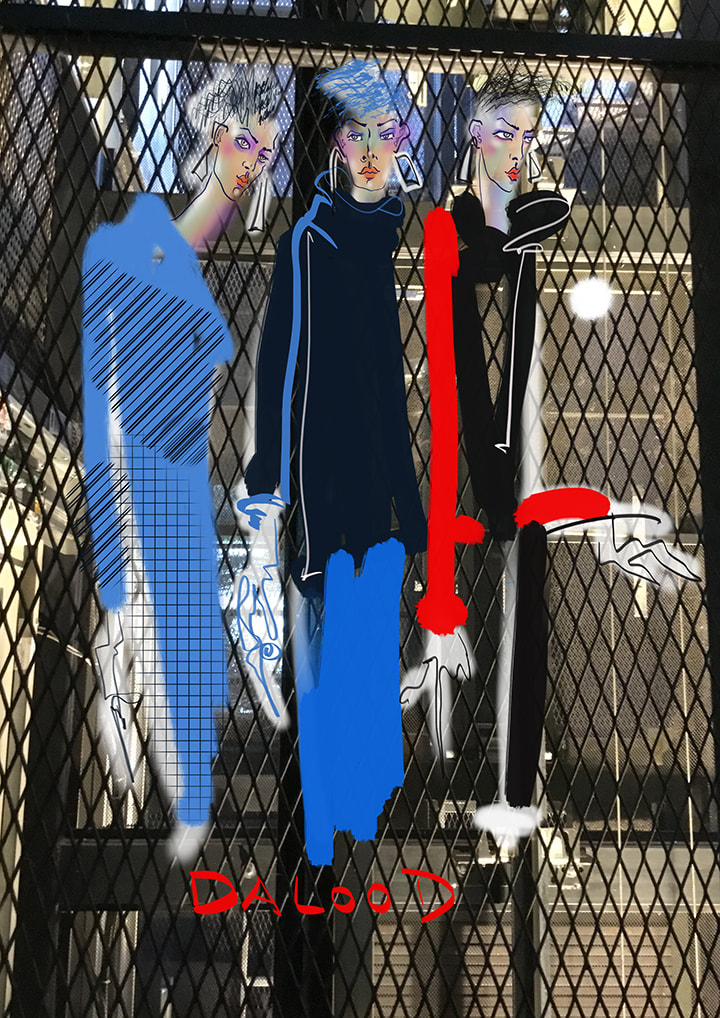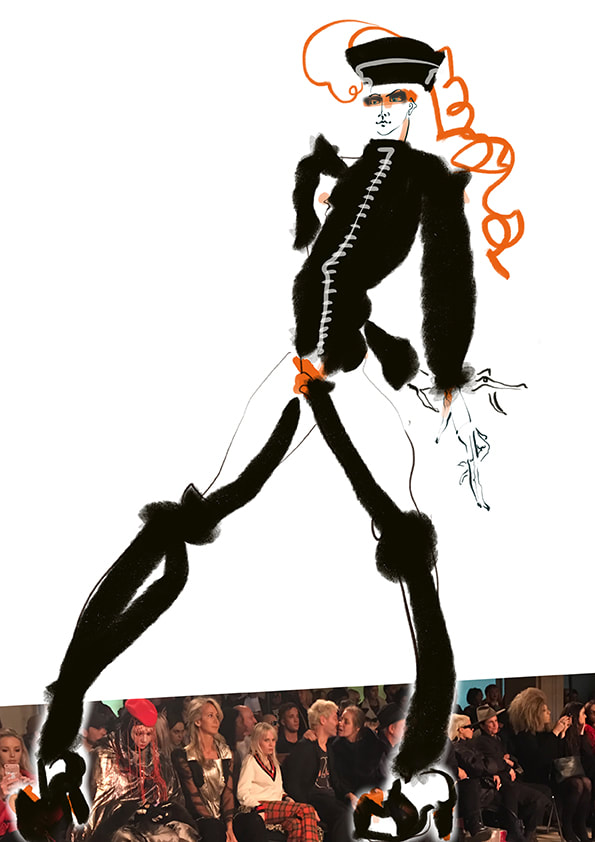|
Arts Editor: Christopher George Like most during this period, Rogers has spent much time close to home. Fueled by the events around the world she's taken this opportunity to dive in to her latest underwater collection, Human. Drama, movement and light come to life in swirls of color, set against the darkness of night in Rogers' depiction of the strength and opposing vulnerability of humanity. With many public exhibitions closed indefinitely, she decided to release this collection online, one image a month, with complimentary outdoor installations around the world. The first being in London on the streets of the design district, with 20 foot outdoor images posted along the walkways. The name human was selected to presuppose a coming together of humanity into a modern renaissance, kindled by adversity and tribulation, and flowering into unforeseen new realities. If art was a passageway into the soul and something more profound within ourselves, she reminds us of our own vulnerabilities within a landscape of hope and magic. In Rogers' unique way, she urges us to look beyond the finite boundaries of what's in front of us, and to see between the spaces into a new future. All of her works are photographed in water, using the refraction of light to create painterly images, and often compared with Baroque and Renaissance paintings. The water within the images flows life to all areas, taking on bold curving forms and transforming everyday people into angelic creatures, seemly from some other place. In these works Rogers hypothesizes the idea that if photons of light are without mass and only perceived because of the eyes, then there must be other things around us that we can not perceive of as of yet. In 2019 Christy Lee Rogers was selected as Open Photographer of the Year for the Sony World Photography Awards. She is a two time finalist for the Contemporary Talents Award from the Fondation François Schneider in France, and has been commissioned by Apple to create underwater images with the iPhone 11Pro, as well as being featured in one of their behind-the-scenes process films. The Independent of London compared her underwater photography to the works of Caravaggio, Delacroix, Rubens and Titian. CNN mentions "Rogers is changing the way water is used in photography to create images that can easily be mistaken for paintings and that push the boundaries of reality." Christy Lee Rogers
2 Comments
Arts Editor: Christopher George No fashion event these days is complete without the presence of legendary illustrator Sue Dray working from the wings, from the front row or in the photographers pit as artist in residence. With a career that has spanned over four decades, Dray has seen the seismic changes in the creative industries, especially in illustration where it was almost wiped out during the 1990s, followed by advent of the digital age. Working both on paper and canvas, and as a digital illustrator, Dray is always in demand due to her adaptability in this ever changing industry. Having studied art during the emergence of women’s liberation in the 1970s, and being good friends with Mike Jones from The CLASH, Dray had first hand experience of the London punk scene before relocating to LA during the 1980s, and this period has inspired her both creatively and culturally. We eventually tracked Dray down, and found her working from an isolated chateau in France. With nowhere for her to escape, she shares her life and career that spans over 40 years, and we would love for you to join us. SO When was the first time you discovered a passion and the gift of illustration? SD Where do I start, I don’t think I have a gift- for me I had no option in life. I was rubbish at the more academic subjects during school, but loved the more creative ones such as Home Economics (mostly cooking) Dress Making/Designing, Art and Music. These were my favourite topics and the ones I seemed in excel in. I suppose I stumbled into illustration and it found me. I never really knew what it was until I went to Art School. But I have always loved getting lost in the activity of drawing, there’s a timeless romance to it. The first fashion illustrator and designer that really ignited and fired me up creatively was the Russian-born French artist Erté. His vision and mind was extraordinary to quote “I start a picture and I finish it. I don’t think about art while I work. I try to think about life”. Erté 1892–1990. On leaving school I went on to study at London College of Fashion, 1972. I was a hell raiser (think I still am) and amazingly in that short year I was there I was elected as Vice President of the student union. My manifesto was to allow women to wear trousers into college. It’s unbelievable that we were not allowed to wear them, not that I did, I preferred voluminous vintage Afghani dresses, but the injustice annoyed me. Remember this was the beginning of the ‘Women’s Liberation Movement’ and I wanted to fight our cause. Needless to say, I was asked to leave the college but at that time I was ready to go. I found the course really limiting. I went on to study at the Hammersmith College of Art and Building in Lime Grove to do a Foundation course in Art. My best mate was Mike Jones who later formed the punk band The Clash. We partied and we drew a lot, and I loved the freedom of producing fantastical images and getting lost in being creative. Illustration just was the natural choice after that. My first commercial commissions on graduating were for the ground-breaking Women’s Liberation Magazine ‘Spare Rib’. I also worked for all the subcultural publishers such as the Women’s Press, Gay News, Gay Men’s Press, Gai Pied in France and Virago. This work is archived in the British Library, and trust me it’s not my best work, but it gave me an inroad into the industry which I have been involved in for the past 48 years. Fast forward to 2011; I was recruited to head up the Fashion Illustration Course at London College of Fashion which coincidently was based at Lime Grove. Starting work there was a real trip and memory lane moment for me, having myself been a student in the same building years earlier. Portia Shaw, Director of POP PR offered tickets for myself and the students to attend the London Fashion Week off schedule shows at Fashion Scout. I told the students, right we are all going to draw from the catwalk, they looked at me horrified saying “how are we going to draw that fast”! I said “just watch me and learn”, to be honest I had never done it myself, but I was sure I could give it a go which I did, and became hooked. Over the last nine years I have built up a reputation of drawing and painting in the front row and back stage for every season. Over the last three years I was invited as Artist in Residence to paint for Fashion Scout with my easel along-side the press photographers. I literally set up my studio squashed in amongst a hundred cameras clicking away. SO It's a unique style of speed drawing. I for one am a huge fan, and have watched over your shoulder many times as you capture the essence of a collection and the models. Can you give me some insight into how it is achieved, how do you zone into that momentary creative time, what are the feeling, and what is the adrenaline you experience during the event, the quick method which is essential during the live action of fashion shows. SD For me it’s pure heaven and that rush as you say of adrenaline is addictive. Waiting for the shows to start, listening to the buzz of the audience as they jostle for their seats all wanting the front row that’s when I get really excited. I fuss over my materials checking I have everything ready to attack my paper or canvas the moment the lights go down and the music goes up as the show starts. It’s at this point I blank out, literally, I am not aware of anything or anybody around me, just on looking at the collection, the models, the shoes, the hair and makeup. I am lost in a whirl of texture, silhouette, fabric, colour and movement. Time has no meaning, it lingers, I stop, take my time but all the while I have to see everything and encapsulate it. I strive in my paintings to recall what we see long after its gone. Since I first started drawing from the catwalk my work has evolved greatly from simple line to spontaneous paintings. It’s taken me many years to train my eye and hand/eye coordination in recording and seeing in an instant. I have to trust my instinct and training. The pieces I produce are not illustrations as such, but my impression of what I see. They are a sort of hybrid inspired from the collection. My current practice of drawing and recording visually are singularly embedded in the restraints of time both physically and mentally. The execution of my work relies on the limit, temporals of time. Without the restriction of time my work can’t exist as it does. This method is essentially about capturing the haptic flow which is in essence about the biology of our sensory receptors. Control and disorder are vital opposites within my work and the keeping the energy, giving imperfection an appreciation, allowing shifting and moving and leakage of the paint. Metaphorically breaking down the walls. SO Your work has taken you globally, and for some time you lived in LA during the early 1980s. Can you give us an insight into your work during this time, as it is so different to where we are now. Also, the roll of an illustrator has changed so much. What would you say those changes have been both negative and positive. SD I moved to Los Angeles on finishing Art School in 1978 because I wanted to experience the Californian life style and live in a David Hockney painting. From the moment I arrived I was in love. I brought myself a 1966 champagne coloured, two door Cadillac, fins and all! I moved to Santa Barbara up the coast from LA, and worked for a ceramic design company painting flowers onto their vases. We had to sign every piece we painted. My nick name was Zetta and I am still known by that name by a whole load of people in the states, and signed off ZETTA followed by a small painted palm tree on the back of the pots. I did commissions painting portraits of people’s beach front properties. Sounds weird but they loved having this crazy English lady sit outside their homes painting away, it was fun and paid my rent. The 80s back in London were heady times, illustration was prolific and consistently used in editorial, advertising and publishing. I was represented by Ian Fleming & Associates in Dean Street when Soho, was mostly a red-light district with amazing late-night cellar bars. I was lucky enough to have produced book jackets for high-profile authors, Fay Weldon, Margaret Atwood and John Mortimer. My biggest regret was that due to my extensive work load I had to turn down illustrating the cover for Anne Frank’s Diary. By contrast, over the years my work has changed considerably, but I am told you can still recognise my line. My work is a bit brutal and raw. I can’t seem to make a pretty or conventionally beautiful drawing I seem to seek out the alternative. This comes from always considering myself as an outsider, never wanting to conform. I always thought myself different, which is why I have sought out inspiration in sub-cultures and people who express themselves alternatively. I find comfort in the unconventional. In this age of youth culture and the focus on the next generation of illustrators and artists, one has to reflect on the artists who were working in 70s & 80s a pre-digital age. We were artists that were at the height of an era that used the drawn image as a means of communication. We were working on the cusp of change before the digital age took hold, almost wiping out the profession. Digital imagery has dominated the commercial landscape over the last 30 years relegating the hand drawn image into almost oblivion. However the pendulum has swung and a new wave of appreciation for the drawn image is having a long-waited resurgence. The industry itself has not really changed much, but as pointed out above communication has, there were no mobile phones, computers or internet. I had one of the first answer phones so I did not miss commissions if I was out seeing clients with my folio. Us illustrators stomped the streets of London dragging our work from one client to the next. We were always seen by the Art Directors, offered a coffee if not lunch. You are lucky today if you ever get to see a client, as everything is done online, so I suppose it’s all become very faceless. The digital takeover has revolutionised society and the working life of an illustrator in every aspect. It’s so easy now to get your work seen via social media which is brilliant. The community of fashion artists is relatively small but we are a close-knit community and we are all constantly supporting each other, this never happened in the past as you worked in total isolation only ever really seeing your agent or the client. SO It must have been an incredible part of your journey witnessing your career. What have been those particular highlights. And also some of the difficult periods with the industry. SD Yes, it’s been a long journey but one I love and I have never regretted my choices. I love teaching and drawing and getting paid for it, what a luxury. I have only recently started to archive my work and seeing the timelines I have travelled through. My archive is large and it spans several decades. I have kept a lot of my work, its squirrelled away, haha though I’m not sure why! Highlights and difficult periods: there are so many highlights where do I start. Possibly the first was being invited out to South Africa to work with Sheelagh Wright from UCA on a collaborative project with Karen Millen, HOPEHIV and Project Gateway in Pietermaritzburg 2006/7/8. The aim of this school is to provide a future in fashion for a young generation affected by both HIV and poverty. It was one of the most important and humbling experiences of my life. Working for Vivienne Westwood drawing backstage. I am also featured in the film, Westwood: Punk, Icon, Activist if only for a nano-second, scribbling away. I love getting the opportunity to paint the maverick and bold Pam Hogg collections, I’ve pretty much drawn all her work since 2013. Another highlight two years ago was artist in residence at the Villa Lena Foundation in Tuscany. I drove out in my old battered camper van and had the most wonderful of experiences working with other international artists from every discipline including the brilliant Tal Walker, concert pianist. I have to also add that over lockdown I have been a guest lecturer at the Royal College of Art and I am involved with a group of incredible students producing a ZINE in collaboration with The Design Museum. I am thrilled to be working with these students and with the college it’s been a life-long dream. The difficult periods are hard to say but I suppose adjusting in the early 90s when illustration simply dried up overnight due to the onset of the computer and in particular Photoshop. Funnily enough years later Apple helped my resurgence as a fashion illustrator by sponsoring me and giving me their new iPad Pro to test out on the catwalk, for a while it was my only tool. I was obsessed with how easy it was to draw with and took it to Paris fashion week and again to Tbilisi fashion week in Georgia. Instead of having to carry a load of paint and paper I simply had to pack my slim line iPad! A huge frustration over the years has been recognition by the ‘Art World’ as there is a lot of snobbery attached to the humble illustrator. Fashion Illustration lies between the two disciplines bridging the gap between high art and commercial art. There is still debate and friction with our profession but one I believe is slowly changing. SO Having separations as a creative is essential for the commercial artist. We all have produced commercial art that is creative. But it is crucial to allow the pure creative to have its time, where it is not under the dependence of commercial control. What has your personal journey been over your career on this balance, that can be difficult for some artists. SD Every illustrator gets frustrated with the constraints of a commercial brief and the seemingly endless changes of the artwork, demanded from the Art Director. Sometimes the work is so over directed that it loses its spirit and the original vision of the artist. Which is why it’s so important for creatives to produce their own work free from commercial control, to keep them both sane and to keep their vision honest and current. When experiencing a dry period such as the lockdown It’s crucial that artists focus on developing their own work, and this enforced period of isolation has been an incredibly rich creative experience for all artists. I am also pursuing a digital special effect animation studio in LA and experimenting in moving image, I want to see my drawings walk! Haha. SO When you are working on your personal work, are you more isolated and do you still have the ability to work with the same ease, as a lot of your work is the total opposite when you are in very busy environments full of energy. SD It’s actually difficult for me when I am doing commissions in my studio, as you know, I thrive off people and atmosphere so my studio can lack the vibe that I love so much. I try to capture and recreate the live situation by timing myself and I always stand to draw, sitting makes my work look lazy with no urgency or life. I also attend lots of themed life drawing classes all over London travelling to Dalston and Borough Market from my home in Battersea, this keeps my eye and hand tuned in. During the lockdown, I have done lots of online classes there are quite a few about but it’s not the same as a live situation. SO It’s unavoidable to be in silence when working on the fashion catwalk. But when you are working in your studio, do you have silence or do you listen to music. Can you let us know what your studio environment is like, along with the music you play. SD As I mostly work away from my studio where I am subject to other music and noise, and during catwalk shows the sound levels are extreme so I tend to blank out sound, having said that I adore classical music something that stirs the soul and makes me feel so in the moment and focused. I love it when I am painting live from the catwalk and the designer plays some dramatic classical or contemporary music, I get swept away with the drama of it all. If I am not listening to music I love radio 4, of course! It’s the plays and stories that I get lost in whilst I am painting. You can’t really talk and you can’t watch TV when drawing and painting, but stories or music just adds to the vibe of painting without the visual distraction. SO Who have been some of your biggest influences over your career. And do you still have a person or genre that you go back to for inspiration. I really can’t say anything or person in particular because there are so many. If I have to name a few people it will be my tutors at art college Glynn Boyd Harte, he encouraged me to draw and draw with confidence. David De Silva for showing me the importance of light and shadow. The fashion illustrators whom I most admire are Jo Brocklehurst who I just adore for her incredible drawings of the punk scene in London, she was the most inspiring artist of her time. Antonio Lopez and Tony Viramontes both master draughtsman who worked extensively during the 80s and sadly both died of AIDS related illness. Also, Rene Gruau and Carl Erickson two of the giants of our profession who worked for the haute couture world during the 40s and 50s. SO Can you let us know 10 items that could represent your ‘Pallet’ as a creative and as a person. This can be anything, any one, sound, colour, shape or experience. SD
SO During such turbulent times the art industry and community can often be that active voice and vision that reaches out. What are your thoughts on this, and the importance and diversity of the creative community. SD I say, without hesitation the creative community are the freethinkers and the boundary pushers of society. They are the people that support what I believe to be the way forward in the world. Socialism, Diversity and Sustainability are all issues that the artist/creatives gravitate towards. Recently I have been so heartened to see such inspirational material on Instagram in support of the Black Lives Matter movement and a few years ago, during the #MeToo movement. Art talks to everyone as it has no language barrier. As visual communicator’s we all have a responsibility to promote social responsibility and in particular sustainability, exactly how we do it is the question. SUE DRAY |
sø•artyCreative minds produce in all mediums. Displaying some of the finest art items edited to suit a refined self and lifestyle Archives
April 2024
|












 RSS Feed
RSS Feed